Although we know a lot about the Bartlett pear, most orchardists, especially in Australia, have been concerned that trees take a long time to come into production, and yields of mature trees are relatively low and fruit is of poor quality.
The use of a vigorous seedling rootstock was often blamed for the poor performance. No wonder much of the research was, and still is, focused on finding the perfect size-controlling rootstock.
Many believe that the performance of Bartlett could only improve if trees were planted at high-density and on a size-controlling rootstock.
Therefore, finding a hardy, size-controlling, precocious rootstock the equivalent of the Malling 9 apple rootstock has been, and still is, the Holy Grail. The pursuit of such a rootstock has been going on unabated for more than 60 years. Some may argue that progress has been made.
Pollinizers
When it became known that cross-pollination enhanced fruit set of Bartlett, orchardists in Australia began to interplant Beurre Bosc (Bosc), which flowered with Bartlett.
However, copper sprays were usually needed to make the skin of the Bosc russet, while Bartlett pears had to remain russet-free.
Packham’s Triumph (Packham) trees were sometimes interplanted with Bartlett trees, but Packham was a poor pollinizer because it flowered earlier than Bartlett.
It was later discovered that the Asian pear variety Nijisseiki (20th Century) was a much better pollinizer, because it started to flower just before Bartlett did, was very precocious, spurry and compact, and bees liked the nectar.
Orchardists who interplanted their old free-standing Bartlett with Nijisseiki and introduced beehives saw that yield increased.
Regulated deficit irrigation (RDI) helped to reduce excessive vigor, but the peculiar fruiting habit of Bartlett made it difficult to match the production of other spur-type pear varieties.
Pyrus calleryana has been widely adopted in Australia since the 1950s. It is hardy enough for arid Australia, compatible with all European pear varieties, easily propagated (from seed), and the scion can be made precocious if well managed.
It was not until Bartlett trees on Pyrus calleryana rootstock were planted closely and trellised, Nijisseiki pollinizers were interplanted, beehives were introduced, RDI, drip irrigation and Ethrel (ethephon) were used to control shoot growth that precocity improved and trees could be brought into full production by year six (see Good Fruit Grower September 2008).
Experiment
In this article, we discuss our experiment where we significantly improved fruitfulness of Bartlett trees on Tatura Trellis, which had performed poorly for 11 years, and changed the traits of Bartlett to show the true production potential of this popular variety.
We increased fruit set of Bartlett trees by improving cross-pollination, using a synthetic stimulant, and controlling vigor.
We focused on tree management—not on waiting and hoping for the right size-controlling rootstock to turn up.
In 2003, a 0.37 hectare (0.9 acre) block of Bartlett on Pyrus calleryana was planted on Tatura Trellis on a 4.5-by-1 meter (3-by-15 foot) spacing with 2,222 trees per hectare (968 trees per acre) at an orchard near Ardmona, Australia. Initially, Packham trees were interplanted (7 percent of trees) as pollinizers and two beehives were introduced during flowering. When eight years old, the trees had only produced a total of 37 tonnes per hectare/bins per acre, so we decided to regraft the Packham trees to Nijisseiki.
In the 11th year, when the Nijisseiki trees had sufficient flowers and beehives were introduced, the Bartlett trees were sprayed with 15 ppm ProGibb SG (gibberellic acid) at 70 percent full bloom, RDI was applied and the tops were delay-headed six weeks after full bloom to maintain canopy height at 2.7 meters (9 feet), measured vertically, which was 60 percent of row width.
Yield increased four-fold (from 19 to 81 tons per hectare/bins per acre), vigor slowed down, and floral buds developed mainly on spurs, not laterals as before.
However, as a result of the long non-productive years, vigor of the Bartlett trees was still a concern.
The 12th-year yield calculation:
The block of 825 Bartlett trees on Tatura Trellis represents 0.371 hectare or 0.928 acre.
Rows are 4.5 meters wide (5 feet), trees are 1 meter (3 feet) apart = 2,222 trees per hectare or 968 trees per acre.
Harvested 122 bins at 389 kilograms = 47.5 tonnes
47.5 tonnes equates to a gross yield of 128 tonnes per hectare/bins per acre. Minus 4 percent culls = 123 tonnes per hectare/bins per acre.
Regalis (prohexadione calcium), which is sold under the brand name Apogee in the United States, was not recommended for pear, partly because of concerns about effects on return bloom and vigorous regrowth, so we experimented in the 12th year with foliar sprays of the growth regulator paclobutrazol (PP333).
The first application was made ten days after petal fall when new shoots were about 25 mm (1 inch) long. The second and third sprays were applied at 10-day intervals after the first spray.
In the experiment in Australia, the effects of foliar sprays of the growth regulator, two beehives, RDI, and delay-heading included:
—Suppressed growth of new shoots and bourse shoots.
—Flowers set fruit in clusters of three and four as a result of less competition for nutrients and carbohydrate reserves between flowers in a cluster (See photo on pages 8-9).
—Restricted early shoot growth, which allowed more nutrient and carbohydrate reserves to go to early fruit growth.
—Good distribution of sunlight throughout the canopies during summer.
—A gross yield of 128 tonnes per hectare/bins per acre and a canning-grade (larger than 65 mm or 2.5 inches) yield of 123 tonnes per hectare/bins per acre.
—The lateral-bearing trait was changed to a predominantly spur-bearing trait, setting the trees up for high sustainable yields and ease of management (See photos above).
In this simple field experiment, using tree management without the use of a size-controlling rootstock, we have shown that Bartlett trees on Tatura Trellis can produce exceptionally high yields of fruit of good size and quality. This enables orchardists to become competitively profitable with this pear, not only for the fresh fruit market but also for processing.
Important note: Neither paclobutrazol nor Apogee are registered for use on pears in the United States. However, Kudos (prohexadione calcium) from Fine Americas is in the experimental phase and might be labeled for pears in the future, according to Dr. Todd Einhorn, horticulturist at Oregon State University.
Read about Einhorn’s research on prohexadione calcium use in d’Anjou and Starkrimson pears in the article “Vigor control and promotion of fruiting of pear trees,” in the February 15, 2013 issue.
Environmental effects on fruit set

Cross-pollination often leads to fertilization but Bartlett pears have no seed, because development of seeds has prematurely stopped, leaving small seed-like structures (integuments).
(Courtesy Bas van den Ende)
Fruit set of Williams Bon Chretien (Bartlett) has been well documented. For instance, it is known that Bartlett is variably parthenocarpic, which means it sets fruit without pollination and pears grow to full size without fertilization.
The rate of parthenocarpic fruit set is genetically determined among pear varieties, but is greatly affected by the environment.
In Australia, it was believed that Bartlett flowers set fruit by vegetative parthenocarpy and fruit grew without any external stimulant, such as pollination or plant growth regulator.
However, trees often took seven to nine years before enough fruit could be harvested, and free-standing trees took at least 17 years to settle down to a modest 40 to 45 tonnes per hectare (40 to 45 bins per acre).
This was partly because trees were planted at low-densities of between 278 and 330 trees per hectare (equivalent to 109 to 134 trees per acre).
Also, the seedling rootstock Pyrus calleryana was used and young trees were pruned hard with many heading cuts made in winter, which resulted in mature trees becoming over-limbed and over-shaded.
Most research on pollination and fruit set of Bartlett showed that cross-pollination increased fruit set compared with self-pollination.
Cross-pollination often led to fertilization, but fruit remained seedless when ripe, because the seeds did not mature, but left small seed-like structures called integuments.
The hormones auxin and gibberellin are produced in seeds in most fruit, and are also produced in high enough concentrations in the fruitlet’s pericarp (the tissue surrounding the seeds) to induce fruit set and maintain fruit growth. —Bas van den Ende and Mick Conti
Bas van den Ende is a fruit consultant in Australia’s Goulburn Valley. Mick Conti is an orchardist in Ardmona.

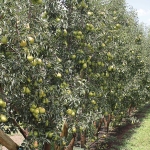
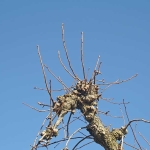
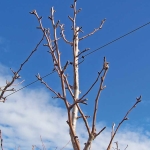
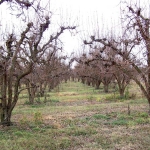
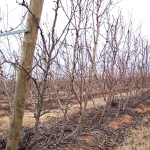





Leave A Comment